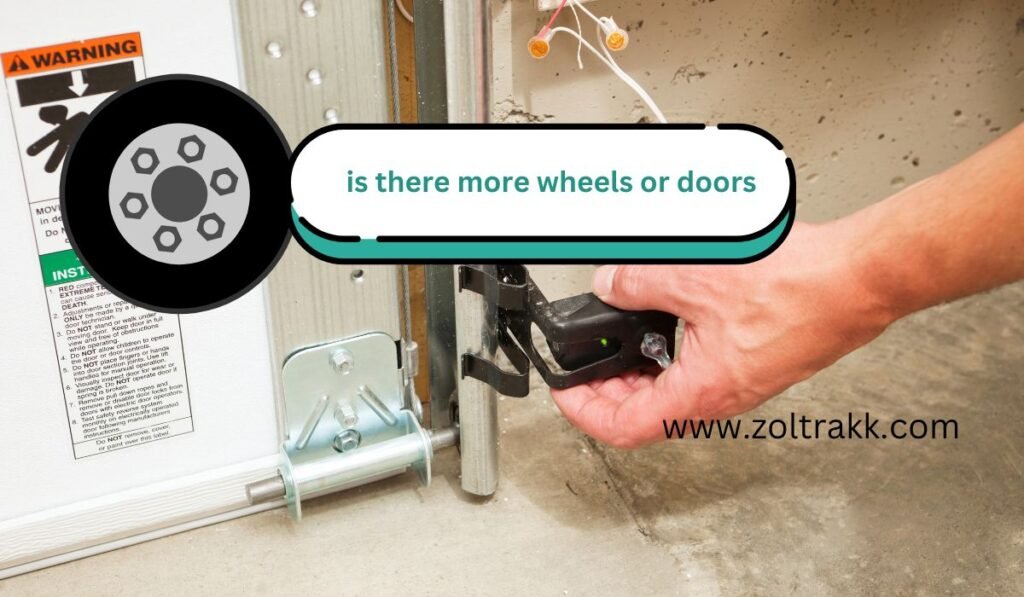Opening
Intense debates on social media, forums, and even among statisticians and data fans about whether there are more wheels or doors in the globe have spurred. Although at first look, this argument seems small, it calls for a thorough knowledge of many sectors, including manufacturing, building, furniture, and automobile. This paper investigates the elements supporting both perspectives using statistical data, logical argumentation, and real-world examples. We shall examine how every category contributes to the worldwide count of wheels and doors, aiming for the most complete response.
Key Takeaways:

- The debate on whether there are more wheels or doors in the world has sparked widespread interest, with compelling arguments for both sides.
- Estimating the global number of wheels versus doors requires analyzing vehicles, furniture, buildings, toys, and more.
- Data shows that with the vast number of vehicles, toys, and equipment with wheels, wheels could outnumber doors.
- On the other hand, residential and commercial buildings with multiple doors offer strong competition.
- A definitive answer remains elusive without more precise data, but we provide a comprehensive analysis to understand both perspectives.
Are There More Wheels or Doors in the World?
There is an ongoing debate about whether there are more wheels or doors in the world. Analyzing data from various sectors such as automotive, real estate, furniture, and toys shows that the answer is not straightforward. While vehicles and toys contribute to a massive number of wheels, buildings, cabinets, and appliances bring an equally overwhelming number of doors. Both sides have compelling evidence, and understanding the prevalence of wheels versus doors involves a deep dive into global statistics, production data, and logical assumptions.
Examining the Wheel Count Worldwide
Several vital categories—vehicles, bicycles, office chairs, and toys—impact the worldwide count of wheels. There are notable numbers in every area; many claim that wheels could surpass doors.
Wheels for Transportation
The most visible players in the worldwide count of wheels are vehicles. Wheelhouses abound in cars, trucks, buses, motorbikes, and bicycles. The International Organization of Motor Vehicle Manufacturers (OICA) estimates that in 2023, 1.45 billion cars and light vehicles will be registered globally.
| Vehicle Type | Estimated Number of Vehicles (2023) | Average Number of Wheels per Vehicle | Total Number of Wheels |
|---|---|---|---|
| Cars | 1.45 billion | 4 | 5.8 billion |
| Motorcycles | 300 million | 2 | 600 million |
| Trucks | 400 million | 6 | 2.4 billion |
| Bicycles | 1 billion | 2 | 2 billion |
| Buses | 3 million | 6 | 18 million |
| Total | – | – | 10.818 billion |
Office Chair wheels
Office chairs and other rolling furniture significantly add to the global wheel count. According to estimates, approximately 400 million office chairs are used worldwide, most of which feature four to five wheels.
- Forecast 400 million office chairs.
- Five wheels on average for each chair.
- Two billion wheels total here.
Toy Wheels
Toys, particularly toy automobiles and trucks, offer still another enormous count of wheels. The toy business is massive, with businesses like Hot Wheels and Matchbox creating over 4 billion toy cars, each usually with 4 wheels.
- Four billion estimated toy cars exist.
- Toy car average wheel count: four.
- Wheel count overall: sixteen billion.
Wheels in industrial equipment

Wheel-based industrial equipment includes shopping carts, forklifts, and machines. Although a precise figure is complex, estimations indicate these groups contribute billions more wheels to the worldwide count.
Estimated Global Total of Wheels
Based on the data from vehicles, office chairs, toys, and industrial equipment, we can estimate the total number of wheels globally:
| Category | Estimated Number of Wheels |
|---|---|
| Vehicles | 10.818 billion |
| Office Chairs | 2 billion |
| Toys | 16 billion |
| Industrial Equipment | 2 billion |
| Total Estimated Wheels | 30.818 billion |
Two billion estimated extra wheels from industrial equipment
Counting the Doors: Analyzing Like wheels, doors are everywhere in many fields: residential and commercial buildings, furniture, appliances, and even cars. Examining the world’s door count helps one grasp these categories and their contributions.
Doors in Structures
Residential and business buildings have the most notable count of doors. The United Nations estimates that 2.2 billion households exist globally. With an average of six doors per house—including kitchens, baths, cupboards, and doors—this is a sizable count.
| Type of Building | Estimated Number of Units | Average Number of Doors per Unit | Total Number of Doors |
|---|---|---|---|
| Residential Homes | 2.2 billion | 6 | 13.2 billion |
| Commercial Buildings | 200 million | 50 | 10 billion |
| Total from Buildings | – | – | 23.2 billion |
Vehicle Doors
Though less often than wheels, vehicles also feature doors. Cars usually have two to four doors; buses, lorries, and other commercial vehicles have more. The number is still noteworthy if we take an average of 4 doors for 1.45 billion cars and various averages for other vehicles.
- Six billion doors are estimated to be found in vehicles.
Furniture and Appliance Doors
Doors also abound in furniture, including cupboards, wardrobes, and equipment like refrigerators. Globally, around 5 billion furniture pieces are thought to feature at least one door. Assuming an average of two doors for every item comes out to be significant.
- Five billion or so estimated furniture items with doors.
- Typical Door Count for Every Item: Two
- Ten billion total doors from appliances and furniture
Estimated Global Total of Doors
Based on available data from buildings, vehicles, furniture, and appliances, the estimated number of doors worldwide is as follows:
| Category | Estimated Number of Doors |
|---|---|
| Buildings | 23.2 billion |
| Vehicles | 6 billion |
| Furniture and Appliances | 10 billion |
| Total Estimated Doors | 39.2 billion |
Wheels against doors: The argument rumbles on.
The study indicates that about 39.2 billion doors and 30.818 billion wheels are used globally. The first look would suggest that doors outnumber wheels. But the numbers can vary greatly depending on things like kinds of buildings, cars, and the presence of smaller objects like toys and tools.
- Factors Affecting Count Variations in Building Types: Usually, commercial structures feature more doors than households. Door counts can be significantly skewed higher by high-rise buildings, offices, and shopping centers.
- Variety of Vehicle Types: Some vehicles, including bicycles and motorbikes, contribute to wheel counts without adding doors.
- Wheel counts are highly influenced by the toy business, especially about tiny automobiles and other rolling objects.
- The emergence of minimalistic design: Minimalist furniture and appliances with fewer doors have recently become trendy, which could lower door counts.
Often asked questions (FAQs) about Wheels vs. Doors
Exist more doors or wheels in the world?
Estimates of current data point to more doors than wheels being found worldwide. Still, the figures are relatively close and mostly rely on assumptions and the inclusion of other categories like office furniture, toys, and industrial equipment.
They are created annually. How many wheels?
Over 1.5 billion car wheels are produced yearly, including replacements and new vehicles. Including office furniture and toys, this count might reach two billion.
Annually, how many doors are produced?
New building construction and furniture production suggest that roughly 3 billion doors are manufactured yearly.
Under what circumstances might the count of wheels and doors change?
These counts are influenced by several elements, including automobile production rates, building trends, toy manufacture, and even the popularity of some furniture designs.
Which nations most help with wheels and doors?
Because of their vast automotive sectors and tremendous urban growth, the United States, China, and India rank among the top donors to both wheels and doors.
Is it ever possible to count precisely the doors and wheels?
An exact count is nearly unattainable given the wide variety of objects with wheels and doors and the absence of centralized data collecting. Still, estimations offer a broad knowledge.
Conclusion
Combining statistical analysis, industry data, and logical reasoning, the argument over whether there are more wheels or doors in the world is fascinating. Although present estimates indicate that doors somewhat outnumber wheels, close competition and data source diversity make it challenging to get at a clear solution. This discussion emphasizes the intricacy of world statistics and the several elements affecting daily objects. One thing is evident regardless of team doors or wheels: the dialogues are far from finished.


